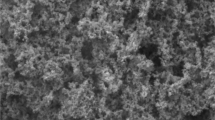Abstract
In this work, the hydration rate and products of blended zeolite cements were studied for periods up to 360 days. Thermoanalytical methods (TG/DTG and DTA) were applied in order to evaluate the hydration rate of blended cements, while. X-ray diffraction and FTIR spectroscopy were used in order to identify the hydrated products. As it is concluded the incorporation of zeolite in cement contributes to the consumption of Ca(OH)2 formed during the cement hydration and the formation of cement-like hydrated products. The pozzolanic reaction of the zeolite is rather slow during the first days of hydration but it is accelerated after the 28 days.









Similar content being viewed by others
References
Taylor HFW. Cement chemistry. 2nd ed., chapter 7, London: Thomas Telford Publishing; 1997.
Tsivilis S, Kakali G, Chaniotakis E, Souvaridou A. A study on the hydration of Portland limestone cement by means of TG. J Therm Anal Calorim. 1998;52:863–70.
Pinto CA, Buchler PM, Dweck J. Pozzolanic properties of a residual FCC catalyst during the early stages of cement hydration: evaluation by thermal analysis. J Therm Anal Calorim. 2007;87(3):715–20.
Dweck J, Ferreira da Silva PF, Silva Aderne R, Buchler PM, Cartledge FK. Evaluating cement hydration by non-conventional DTA: an application to waste solidification. J Therm Anal Calorim. 2003;71(3):821–7.
Perraki M, Perraki T, Kolovos K, Tsivilis S, Kakali G. Secondary raw materials in cement industry. Evaluation of their effect on the sintering and hydration processes by thermal analysis. J Therm Anal Calorim. 2002;70(1):143–50.
Pacewska B, Blonkowski G, Wilinska I. Studies on the pozzolanic and hydraulic properties of fly ashes in model systems. J Therm Anal Calorim. 2008;94(2):469–76.
Cherem-da Cunha AL, Gonçalves JP, Büchler PM, Dweck J. Effect of metakaolin pozzolanic activity in the early stages of cement type II paste and mortar hydration. J Therm Anal Calorim. 2008;92(1):115–9.
Giergiczny Z. The hydraulic activity of high calcium fly ash. J Therm Anal Calorim. 2006;83(1):227–32.
Fragoulis D, Chaniotakis E, Stamatakis M. Zeolitic tuffs of Kimolos Island, Aegean Sea, Greece and their industrial potential. Cement Concrete Res. 1997;27(6):889–905.
Martinez-Ramirez S, Blanco-Varela MT, Erena I, Gener M. Pozzolanic reactivity of zeolitic rocks from two different Cuban deposits: characterization of reaction products. Appl Clay Sci. 2006;32(1–2):40–52.
Ortega E, Cheeseman C, Knight J, Loizidou M. Properties of alkali-activated clinoptilolite. Cement Concrete Res. 2000;30(10):1641–6.
Poon C, Lam L, Kou S, Lin Z. A study on the hydration rate of natural zeolite blended cement pastes. Constr Build Mater. 1999;13(8):427–32.
Turkmenoglu AC, Tankut A. Use of tuffs from central Turkey as admixture in pozzolanic cements: assessment of their petrographical properties. Cement Concrete Res. 2002;32(4):629–37.
Perraki Th, Kakali G, Kontori E. Characterization and pozzolanic activity of thermally treated zeolite. J Therm Anal Calorim. 2005;82(1):109–13.
Perraki Th, Kakali G, Kontoleon F. The effect of natural zeolites on the early hydration of Portland cement. Micropor Mesopor Mat. 2003;61(1–3):205–12.
Stamatakis M, Hall A, Hein JR. The zeolite deposits of Greece. Miner Deposita. 1996;31(6):473–81.
Mostafa N, El-Hemaly S, Al-Wakeel E, Korashy S, Brown P. Characterization and evaluation of the pozzolanic activity of Egyptian industrial by-products: I: silica fume and dealuminated kaolin. Cement Concrete Res. 2001;31:467–74.
Author information
Authors and Affiliations
Corresponding author
Rights and permissions
About this article
Cite this article
Kontori, E., Perraki, T., Tsivilis, S. et al. Zeolite blended cements: evaluation of their hydration rate by means of thermal analysis. J Therm Anal Calorim 96, 993–998 (2009). https://doi.org/10.1007/s10973-009-0056-x
Received:
Accepted:
Published:
Issue Date:
DOI: https://doi.org/10.1007/s10973-009-0056-x




